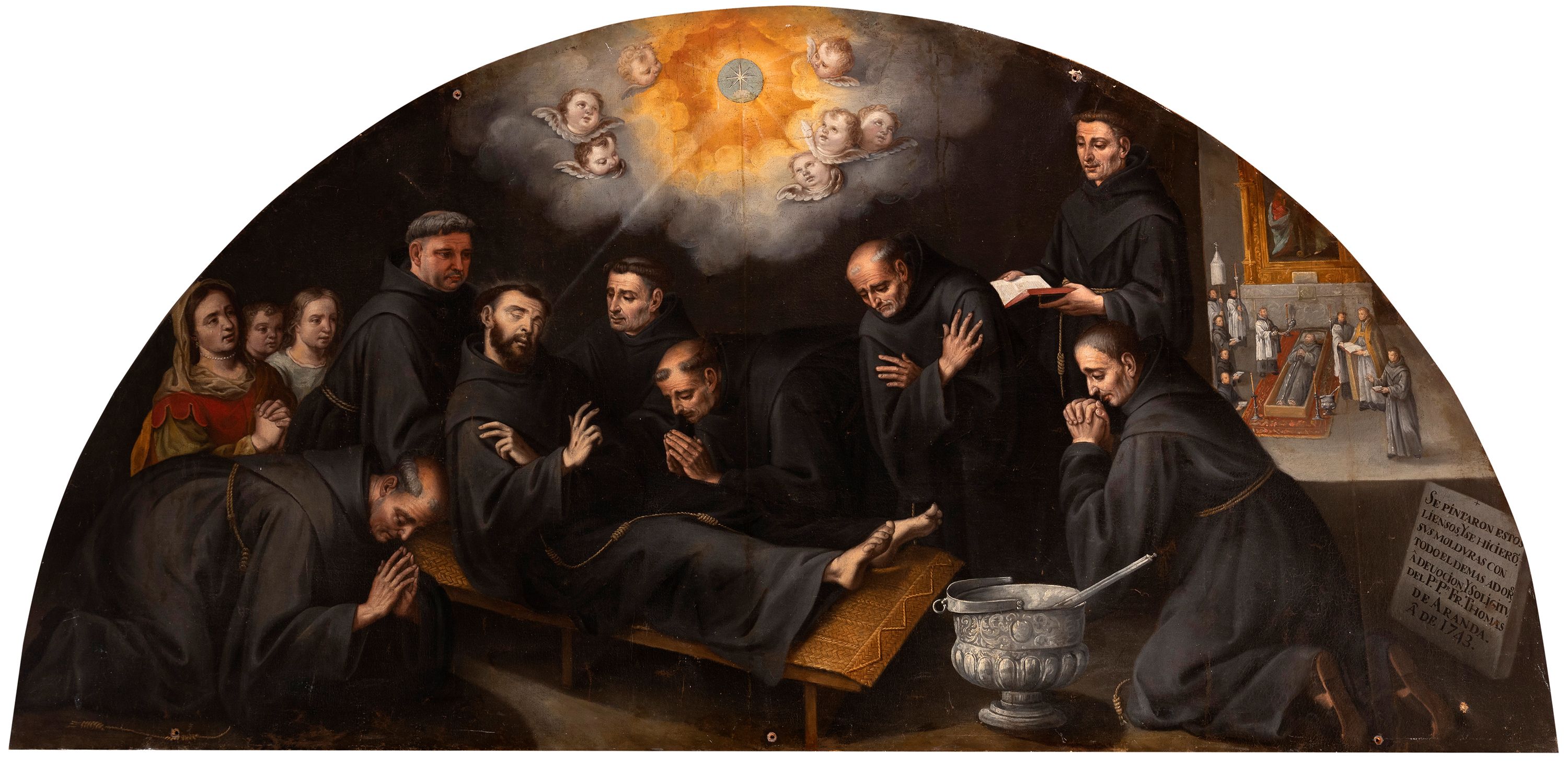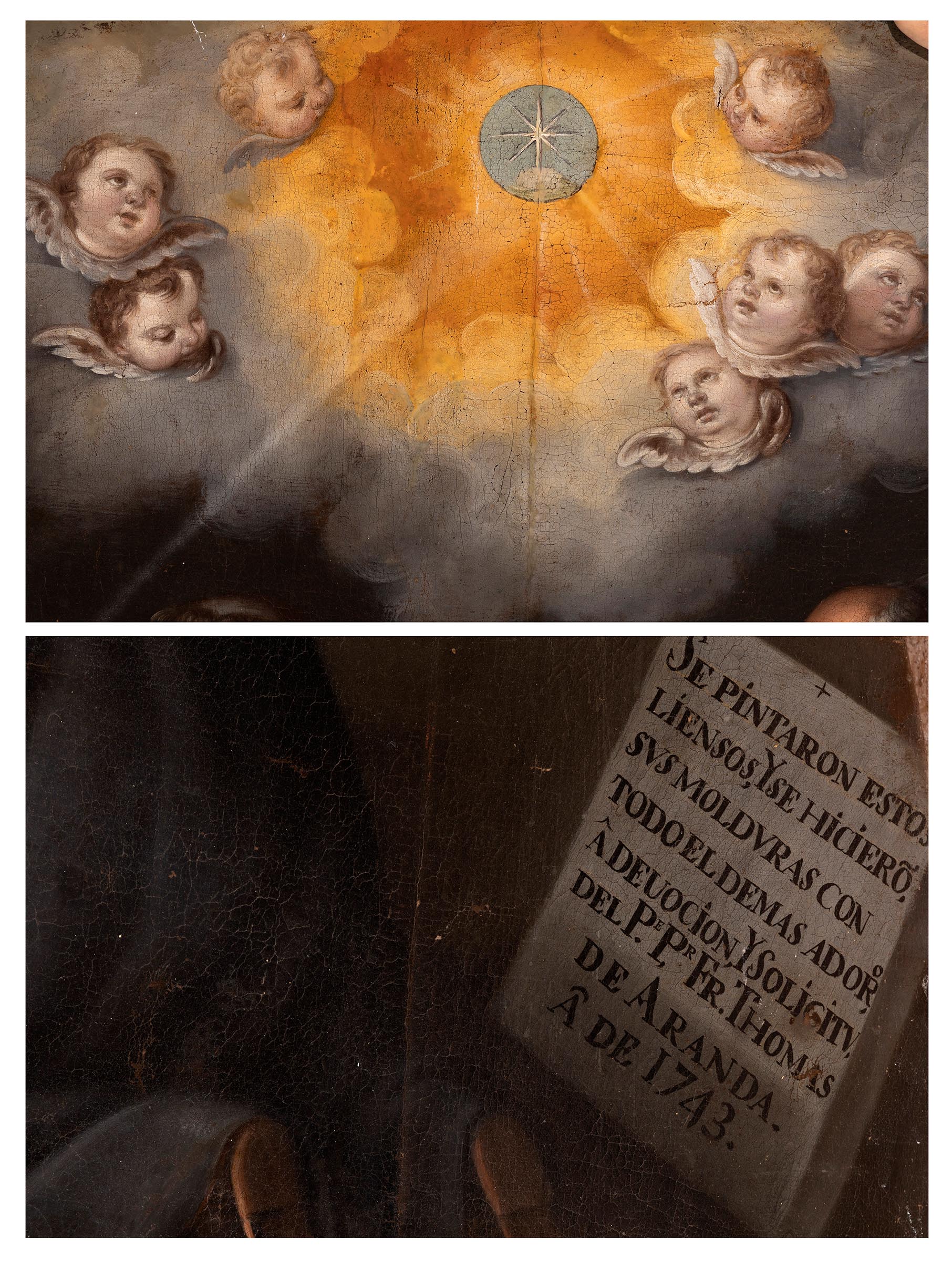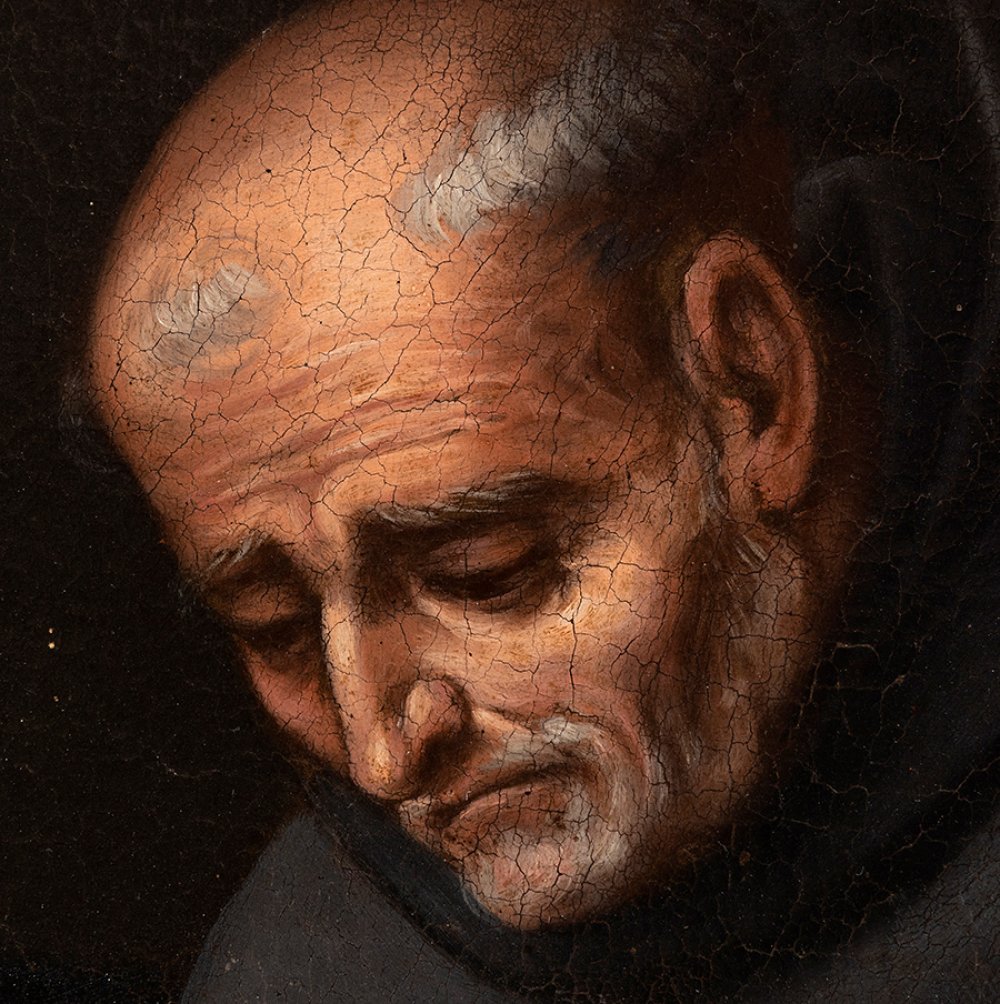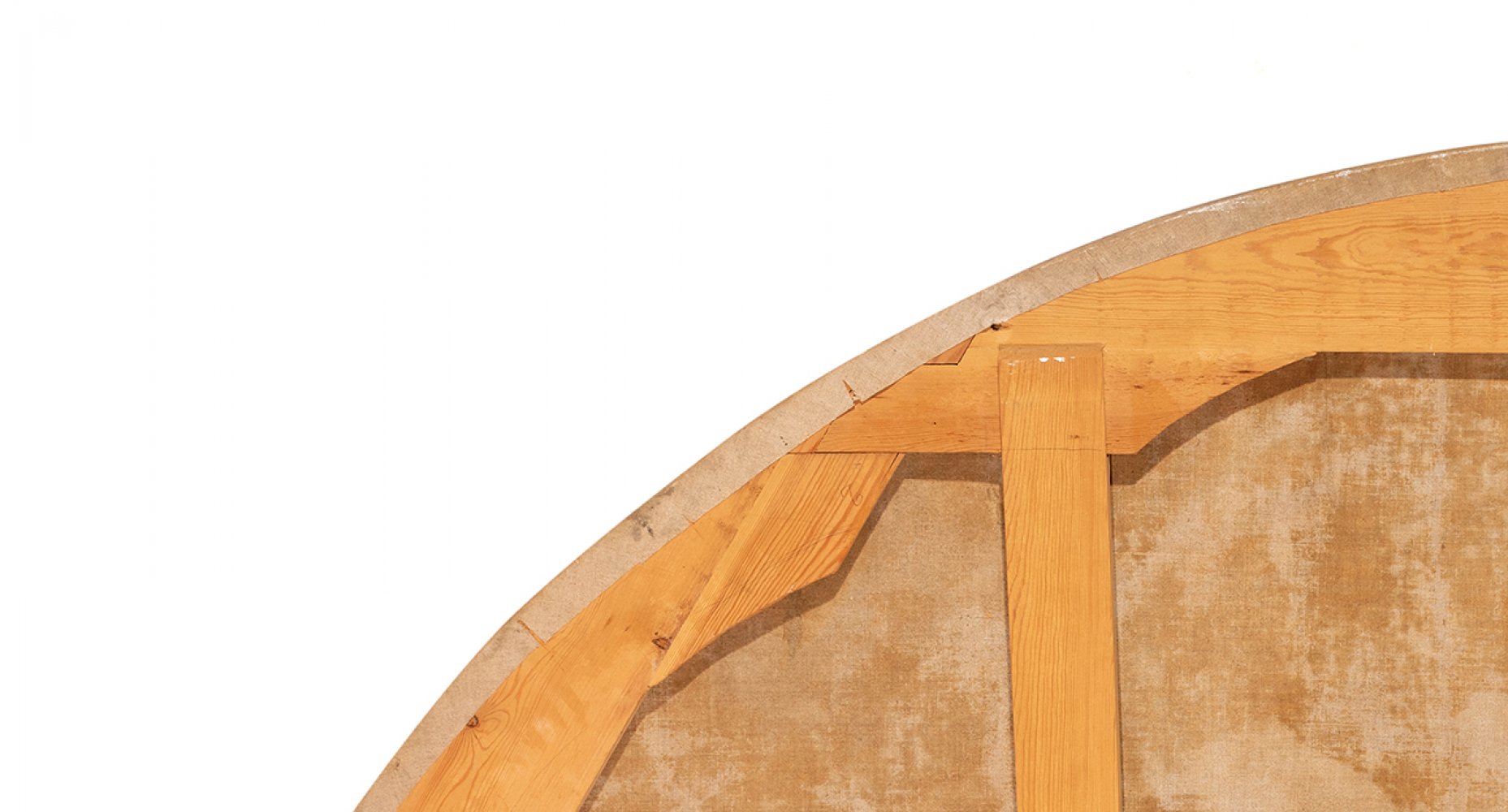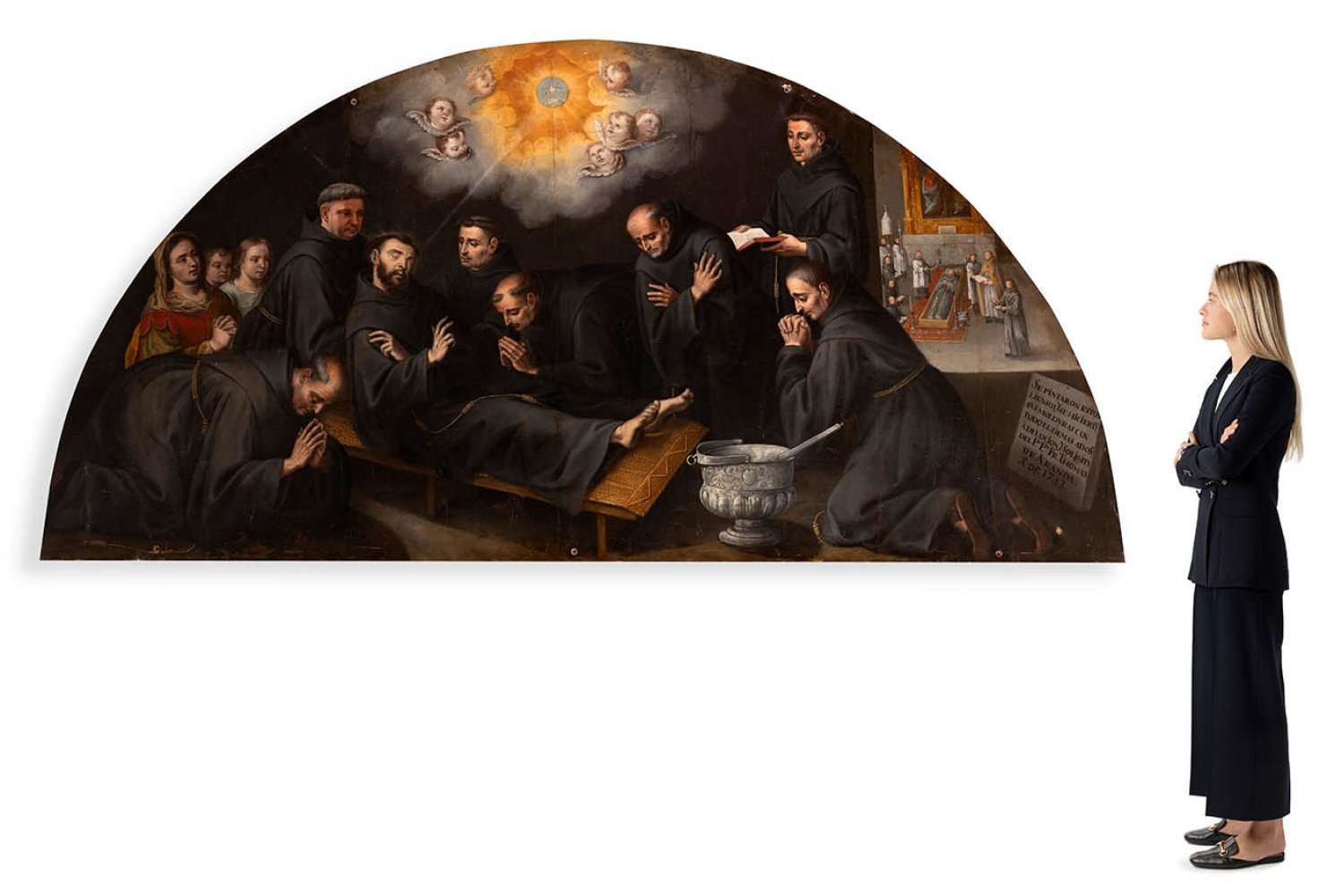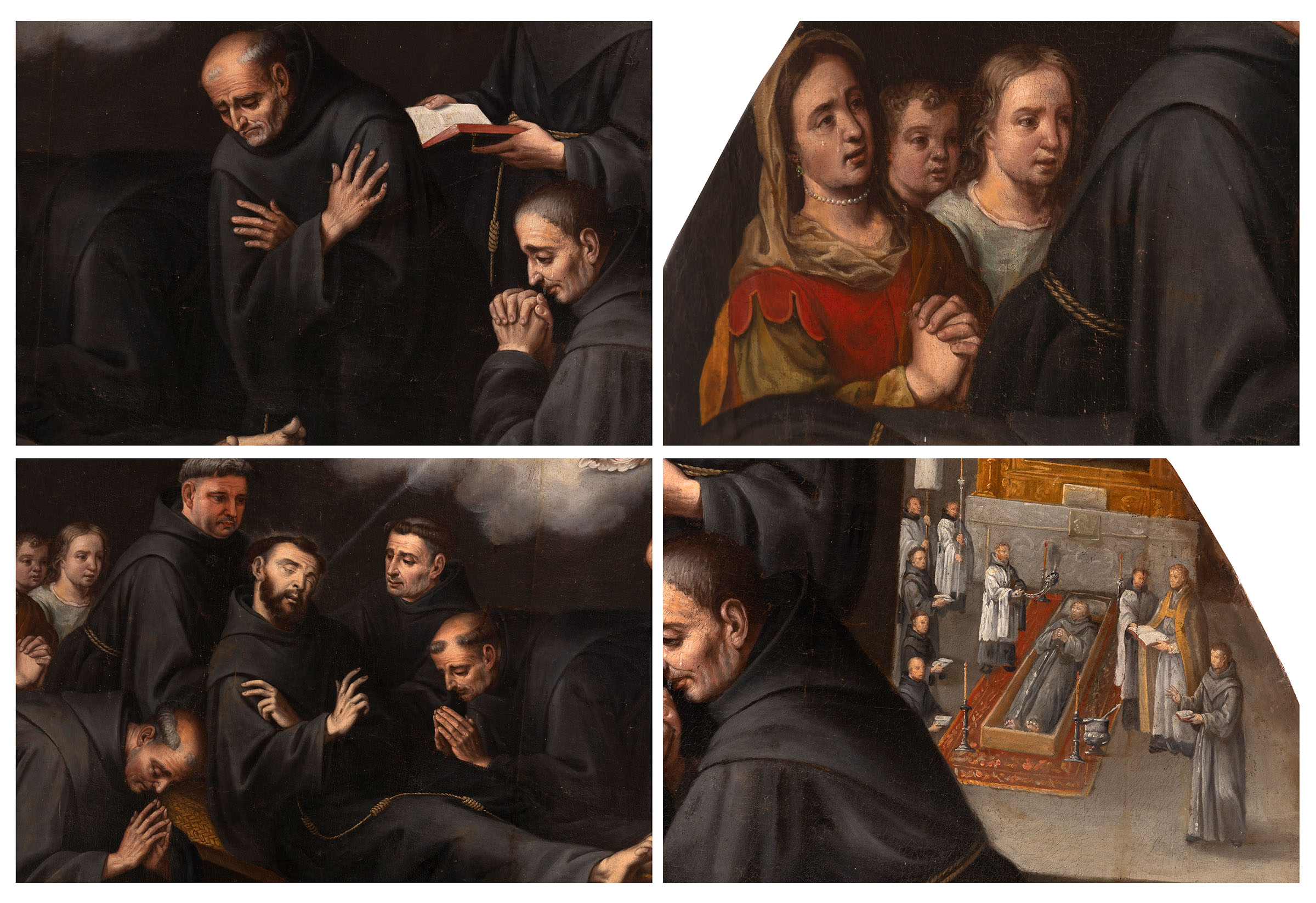49
JUAN RUIZ SORIANO (Higuera de la Sierra, Huelva, 1701 - Seville, 1763)."The Death of Saint Francis",
"The Death of Saint Francis", 1743.
Oil on canvas. Relined.
It has repainting and restorations.
Presents inscription with date.
Measurements. 139 x 275 cm.
The semicircular format of this work indicates that it is a painting intended as a decorative element, perhaps with the intention of ornamenting the upper areas of an opening, or another architectural space. Of a devotional nature, the artist has depicted the death of Saint Francis, who is lying in the centre of the composition with his eyes closed and his hands with the stigmata on his chest. Saint Francis, the protagonist of the scene, is surrounded by numerous religious of his order who are watching over his corpse, all of whom adopt a different attitude and have different physical features, which shows the artist's mastery. The central image, of a sober and austere character, is relieved by the artist through three elements: the glory break located in the upper area, the family on the left, perhaps representing some donors, whose clothes stand out against the rigorous black of the friars, and finally the presence of a small space on the right, where the official burial of Saint Francis can be seen, already in his coffin.
Born in the town of Higuera de Aracena, now Higuera de la Sierra, Juan Ruiz Soriano trained in Seville with his cousin Alonso Miguel de Tovar (Higuera de la Sierra, 1678 - Madrid, 1752), and began painting in 1725. As a disciple of Tovar, it is logical that Ruiz Soriano's art should at the same time derive from that of Murillo, which is why his pictorial production is characterised by a soft, gentle drawing. We know that he worked for numerous religious orders, which asked him to produce a series of paintings to decorate their cloister walls. He must also have worked extensively for private individuals. The present canvas shows the direct influences of both Ruiz Soriano and Tovar, so it could be deduced that the artist is a painter from the circle of the former and a follower of the latter. Both masters derived their models from Murillo, as was common among 18th-century Sevillian painters, and this influence is also evident in this canvas, both in the sketchy treatment, with its elaborate classical tones, and in the figures themselves, which are painted with a marked sense of expressive affability and serenity. Within Alonso Miguel de Tovar's production we frequently find the same theme as the present painting, depicted in a very similar compositional model. In the "Divinas Pastoras" in the parish church of Cortelazor, the one in Higuera de la Sierra and the one in the Museo del Prado, all typical of Tovar's style, Mary appears seated on a rock against a landscape background enclosed on the left, dressed in a pink tunic, blue cloak and sheepskin sackcloth, holding a rose in her left hand and caressing a sheep's head with her right. In all of them, moreover, the animals approaching the figure hold roses in their mouths as an offering to Mary. The rest of the elements of the composition are identical to those in Tovar's, including the secondary scene in the background, in which an archangel is depicted fighting a demon who intends to attack a lamb holding a phylactery with the text "Ave Maria" in its mouth. Thus, the only iconographic differences with respect to Tovar's work are the Virgin's crown and the archangel, who in the work by the master from Higueras de la Sierra carries a flaming sword, while here he appears unarmed. Another differentiating element, although secondary in terms of iconography, is that in this work an angel appears holding Mary's staff, while in Tovar's works the staff appears leaning against the rock.
"The Death of Saint Francis", 1743.
Oil on canvas. Relined.
It has repainting and restorations.
Presents inscription with date.
Measurements. 139 x 275 cm.
The semicircular format of this work indicates that it is a painting intended as a decorative element, perhaps with the intention of ornamenting the upper areas of an opening, or another architectural space. Of a devotional nature, the artist has depicted the death of Saint Francis, who is lying in the centre of the composition with his eyes closed and his hands with the stigmata on his chest. Saint Francis, the protagonist of the scene, is surrounded by numerous religious of his order who are watching over his corpse, all of whom adopt a different attitude and have different physical features, which shows the artist's mastery. The central image, of a sober and austere character, is relieved by the artist through three elements: the glory break located in the upper area, the family on the left, perhaps representing some donors, whose clothes stand out against the rigorous black of the friars, and finally the presence of a small space on the right, where the official burial of Saint Francis can be seen, already in his coffin.
Born in the town of Higuera de Aracena, now Higuera de la Sierra, Juan Ruiz Soriano trained in Seville with his cousin Alonso Miguel de Tovar (Higuera de la Sierra, 1678 - Madrid, 1752), and began painting in 1725. As a disciple of Tovar, it is logical that Ruiz Soriano's art should at the same time derive from that of Murillo, which is why his pictorial production is characterised by a soft, gentle drawing. We know that he worked for numerous religious orders, which asked him to produce a series of paintings to decorate their cloister walls. He must also have worked extensively for private individuals. The present canvas shows the direct influences of both Ruiz Soriano and Tovar, so it could be deduced that the artist is a painter from the circle of the former and a follower of the latter. Both masters derived their models from Murillo, as was common among 18th-century Sevillian painters, and this influence is also evident in this canvas, both in the sketchy treatment, with its elaborate classical tones, and in the figures themselves, which are painted with a marked sense of expressive affability and serenity. Within Alonso Miguel de Tovar's production we frequently find the same theme as the present painting, depicted in a very similar compositional model. In the "Divinas Pastoras" in the parish church of Cortelazor, the one in Higuera de la Sierra and the one in the Museo del Prado, all typical of Tovar's style, Mary appears seated on a rock against a landscape background enclosed on the left, dressed in a pink tunic, blue cloak and sheepskin sackcloth, holding a rose in her left hand and caressing a sheep's head with her right. In all of them, moreover, the animals approaching the figure hold roses in their mouths as an offering to Mary. The rest of the elements of the composition are identical to those in Tovar's, including the secondary scene in the background, in which an archangel is depicted fighting a demon who intends to attack a lamb holding a phylactery with the text "Ave Maria" in its mouth. Thus, the only iconographic differences with respect to Tovar's work are the Virgin's crown and the archangel, who in the work by the master from Higueras de la Sierra carries a flaming sword, while here he appears unarmed. Another differentiating element, although secondary in terms of iconography, is that in this work an angel appears holding Mary's staff, while in Tovar's works the staff appears leaning against the rock.
9th November - Old Masters
Sale Date(s)
Venue Address
General delivery information available from the auctioneer
Setdart offers Worldwide shipping
PICK UP IN ROOM: You can come and pick up your lots in our offices (Barcelona, Madrid or Valencia). At the moment of the withdrawal, you will be able to accept the current conditions of the lot by means of a document that you will sign.
YOU CAN SEND ANOTHER PERSON TO PICK UP: This person must present a signed authorization that you can find in our web page by accessing from BUY AT SETDART- LOGISTICS-DOWNLOAD AUTHORIZATION DOCUMENT. You can also send an e-mail with the requested data in AUTHORIZATION DOCUMENT to admin@setdart.com
Important Information
25% buyer´s premium
OR
21% buyer´s premium at www.setdart.com
Terms & Conditions
The maximum period to pay the lots is 7 working days. You can pay either via bank transfer or with credit card through our platform www.setdart.com (we only accept VISA or Mastercard).
BUYER´S PREMIUM: 22% Hammer price + 21% VAT from the buyer´s premium
If your piece has more than 100 years, our Ministry of Culture requires an export certificate in order for the piece to leave the country. Note that if the piece goes inside the EU, there is no cost for the export certificate. If the piece goes outside the EU, there is a cost for the export certificate. You can find more information in our Ministry of Culture website: https://www.culturaydeporte.gob.es/en/cultura/patrimonio/exportacionimportacion/exportacion/tasas.html
INQUIRIES: admin@setdart.com
Setdart guides you through the entire process, from the time of award to the day you receive your lot. Our logistics team will be happy to manage your transport, and will advise you on the best shipping method with professionals from the sector used to handling works of art and jewelry.
WE OFFER WORLDWIDE DOOR TO DOOR SHIPPING
PICK UP IN ROOM: You can come and pick up your lots in our offices. At the moment of the withdrawal, you will be able to accept the current conditions of the lot by means of a document that you will sign.
YOU CAN SEND ANOTHER PERSON TO PICK UP: This person must present a signed authorization that you can find in our web page by accessing from BUY AT SETDART-LOGISTICS-DOWNLOAD AUTHORIZATION DOCUMENT. You can also send an e-mail with the requested data in AUTHORIZATION DOCUMENT to admin@setdart.com
SETDART IS NOT RESPONSIBLE FOR THE STATE OF THE PARTS ONCE THEY LEAVE OUR FACILITIES. MRW SHIPMENTS: Once the payment is made, your lot will be packed for shipment, the logistics department will send you an e-mail notifying you of the day it leaves our warehouse, changes of address cannot be made after receiving this e-mail.
INSURANCE INCIDENTS: Coverage for the value of the auction up to 3000 ? per shipment, if the value of the auction is higher, Setdart will send you a quote including the additional insurance. The insurance company WILL NOT BE RESPONSIBLE FOR THE SHIPMENT THAT EXCEEDS THAT AMOUNT AND IS NOT FULLY INSURED. MRW INCIDENTS: Maximum notification 48 hours after receipt, after which the insurance company WILL NOT BE RESPONSIBLE AND NO CLAIMS WILL BE ACCEPTED.
E-MAIL LOGISTICS: logistica@setdart.com
PICK UP YOUR MESSAGES: You can send your own messaging, prior notice via e-mail that your shipment is ready, please note 3 or 4 days in advance. This type of shipment is packaged so Setdart will provide you with a quote.
EXPENSES FOR STORAGE: We inform you that if the purchased lot is not picked up within a month, you will be charged 30€ per week per lot. Setdart Online S.L., owner of the web site "setdart.com", "setdart.net" and "setdart.org", acts as a company of Spanish nationality inscribed in the Volume 36955, sheet 182, page B-293056 of the Mercantile Registry, with registered office at Calle Aragó















